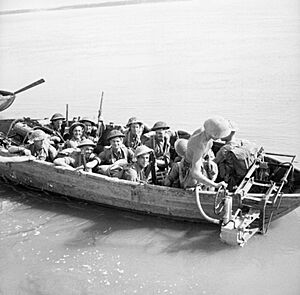Battle of Pokoku and Irrawaddy River operations facts for kids
Quick facts for kids Battle of Pakokku and Irrawaddy River |
|||||||
|---|---|---|---|---|---|---|---|
| Part of Central Burma Campaign | |||||||
 A Lee tank loaded onto a pontoon ferry by British troops before crossing the Irrawaddy River at Ngazun, 28 February 1945 |
|||||||
|
|||||||
| Belligerents | |||||||
| Commanders and leaders | |||||||
| Strength | |||||||
| Casualties and losses | |||||||
| unknown | unknown | ||||||
The Battle of Pakokku and Irrawaddy River operations were important battles during World War II. They took place in Burma (now Myanmar) between February and May 1945. The fighting involved the British Indian Army against the Imperial Japanese Army and their allies. These battles were a key part of the larger Burma campaign. They helped the Allied forces capture Rangoon, the capital city, in the summer of 1945.
Contents
Background to the Battle
Planning the Attack
Earlier in the war, the Japanese army had faced big defeats. Their attacks at Kohima and Imphal had failed. They lost many soldiers, perhaps as many as fifty thousand. Usually, fighting would slow down during the monsoon season (rainy season). But in 1944-45, the Allied commanders decided to keep pushing. They wanted to attack the main Japanese forces in Burma.
General William "Bill" Slim led the British Fourteenth Army. His plan was to chase the Japanese from Kohima and Imphal. He wanted to move into central Burma, especially around Mandalay. This area was good for using tanks. The Allied forces crossed the Chindwin River. This surprised the Japanese, who didn't expect a big attack during the monsoon.
Crossing the Irrawaddy River
The next big challenge was the Irrawaddy River. It's about 2,000 yards (1,800 meters) wide in the middle. It also has tricky sand bars. Crossing it while the enemy was watching would be very dangerous. So, General Slim came up with a clever plan. He decided to make several crossings. He would try to trick the Japanese about where the main attack would happen.
The plan was to make a strong crossing north of Mandalay. This would draw the main Japanese forces there. But the real, main attack would happen further south. The 7th Indian Infantry Division was given a special role. They would move south for almost 300 miles (480 km). Their job was to capture a crossing point (called a bridgehead) at Pakokku on the Irrawaddy. From there, they would quickly move towards Meiktila and Thazi. Capturing Meiktila would cut off many Japanese troops in northern and central Burma.
The 7th Division's Mission
The 7th Indian Infantry Division's mission was very brave and clever. It was crucial for defeating the Japanese in Burma. The 114th Indian Infantry Brigade started the operation. They built a 180-mile (280 km) road from Tamu to Gangaw in just 15 days! This helped the troops move quickly.
The advance began on January 19, 1945. The 7th Indian Infantry Division had two main goals:
- To capture the Pauk area and cross the Yaw Chaung river by February 1, 1945.
- To secure a bridgehead over the Irrawaddy River between Chauk and Pakokku. This crossing point needed to be ready for the advance to Meiktila by February 15, 1945.
Battle of Pakokku
The Japanese had been defeated in earlier battles. The plan was to surprise them by crossing the Irrawaddy River. The 7th Indian Infantry Division was to secure a crossing point at Pakokku. They needed to do this by February 15, 1945.
The 114th Indian Infantry Brigade led the way. The 4th Battalion, 5 Royal Gurkha Rifles (Frontier Force) (4/5 GR) was at the front. They reached Pakokku on February 5, 1945. The Japanese were firing at them from Kahnla village, across the river.
On February 5, three companies of 4/5 GR attacked Kahnla village. They surrounded the village. One company attacked from the northeast. Another company attacked from the west. The fighting was tough. They captured half of the Japanese position, including a strong machine gun bunker. At least 30 Japanese soldiers were killed. The Gurkha soldiers captured many weapons. A brave soldier named CHM Bhagta Bahadur Gurung showed great courage. He was later given a special award called the Indian Order of Merit.
On February 6, the Gurkhas found that the rest of the Japanese position was still very strong. On February 7, another Gurkha battalion, the 4th Battalion/1 Gurkha Rifles (4/1 GR), set up a strong base for 4/5 GR. On February 8, Brown's company cleared another Japanese position. They killed twelve Japanese soldiers.
The main attack was planned for February 10. Bad weather meant there was no air support. But the attack went ahead. One company moved forward with support from tanks from the 255th Indian Tank Brigade. By afternoon, they had captured their target. The 4/5 GR lost their commanding officer, which was a big blow. The Japanese fought very hard. Only one Japanese soldier was captured, and 51 bodies were counted.
The Japanese launched six counterattacks on the night of February 10. All of them failed. They tried to sneak into the Gurkha positions on February 11 and 12, but also failed. On February 13, the 4/5 GR moved closer to Pakokku Village. They then searched and took control of Pakokku itself. This battle greatly weakened the Japanese forces. The 7th Indian Infantry Division had secured a foothold on the western bank of the Irrawaddy. This was a very important step for the next phase of the war.
Irrawaddy River Operations
After the 7th Indian Infantry Division captured Pakokku, the Allied forces crossed the Irrawaddy River on February 14. They crossed at Nyaung U, near the ancient city of Pagan. The 7th Division attacked across a wide area. The main attacks at Nyaung U and Pagan were very difficult at first.
Pagan and Nyaungu were defended by two battalions of the Indian National Army. The 7th Indian Division faced heavy machine-gun fire. Their assault boats were damaged. But with help from tanks and many artillery guns, the defenders at Nyaungu surrendered. At Pagan, the Indian National Army's 9th Battalion fought bravely against the (1/11th Sikh Regiment) before they pulled back.
By February 20, most of the Allied forces had crossed the river. They then captured Meiktila, just as planned. The capture of Pakokku by the 4/5 GR opened the way for the 17th Indian Infantry Division to move forward. On February 19, the 4/5 GR also cleared a large island in the Irrawaddy River near Pakokku. This island had been blocking their movement.
On February 24, the Gurkhas moved south of Pakokku. They crossed the Irrawaddy River and took over part of the Nyaung U bridgehead. On February 25, tanks from the 255th Indian Tank Brigade helped the Gurkhas attack a village. The village was quickly secured. Seven Japanese soldiers were killed.
Throughout April, the Allies continued fighting the Japanese in the area. They captured Letse and Seikpyu. On April 24, troops faced heavy fire from a ridge with a Golden Pagoda and a monastery. A company from 4/5 GR, supported by heavy artillery, captured this important position. Thirty-nine Japanese bodies were found. By April 30, the 4/5 GR secured Pwinbu. Then they moved to clear the Japanese from Pagan village. Between May 5 and 8, they launched strong attacks on Japanese positions around Pagan.
Aftermath
While these battles were happening west of the Irrawaddy River, the main Battle of Mandalay was also fought. The Japanese were completely defeated there. The Japanese Army in Burma was no longer an organized fighting force.
On May 2, 1945, Rangoon was recaptured. General Slim's plans had worked perfectly. The monsoon season was about to begin. The next step was to clear out any remaining Japanese forces. On May 14, the 4/5 GR left Pagan. They hoped to find a permanent base for the rainy season. After moving a few times, they arrived at Allanmyo. On May 27, they received new orders to move to Prome for more tasks.
Because of their brave actions in this battle, the 4/5 GR was given a special award called the "Irrawaddy" Battle Honour.


